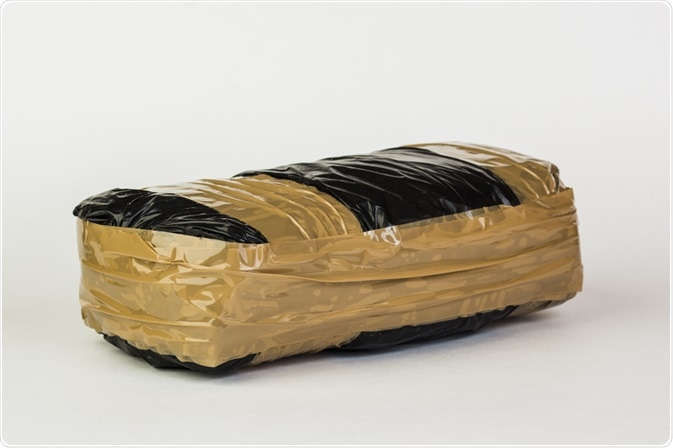Although there are certain limitations associated with wipe-based trace detection approaches, recent work conducted by the National Institute of Standards and Technology in Gaithersburg, Maryland looked to utilize this collection method for analysis by thermal desorption direct analysis in real-time mass spectrometry (TD-DART-MS).

Image Credit: Fuss Sergey/Shutterstock.com
Field testing of controlled substances
For several decades, law enforcement officers were allowed to perform simple presumptive field tests to confirm the presence or absence of controlled substances like cocaine, heroin and other narcotic substances.
Unfortunately, due to the extremely harmful and even lethal health effects that can occur following the handling of synthetic opioids and other novel psychoactive substances (NPSs), such as fentanyl, law enforcement agencies have abandoned this previously common practice.
Current presumptive testing methods
To eliminate the potential exposure of law enforcement officers to bulk powders, two primary types of presumptive testing can be performed.
Spectroscopy techniques, of which include Raman spectroscopy and/or Fourier transform infared (FTIR) spectroscopy, are capable of detecting chemical substances present within their packaging material.
While useful, most spectroscopy-based techniques are unable to accurately describe contents that have a mass fraction of 10% or less. Furthermore, spectroscopy-based techniques are also limited in their ability to detect substances present within packaging that is not transparent or semi-transparent.
The second type of commonly employed presumptive testing includes trace detection technologies, which can include ion mobility spectrometry (IMS), lateral flow immunoassays (LFIs) and portable mass spectrometry (MS).
Many of these trace detection methods require a wipe-based collection technique, in which only remnant particulate residue present on the exterior of the packaging material will be tested. While trace detection methods are not associated with the same packaging and sensitivity limitations of spectroscopy techniques, the collection method for trace detection methods is not very selective.
To this end, any type of dirt or plasticizer agent present on the surface of the external packaging, in addition to the drug residue, will be collected and measured.
Wipe-based collection and TD-DART-MS analysis
In a recent 2019 study, researchers utilized samples that were collected from actual evidence submissions at either the Maryland State Police Forensic Sciences Division or the Vermont Forensic Laboratory.
Meta-aramid wipes were used to collect any available trace residue present on both outer packaging that contained the piece of evidence, as well as the exterior surface of the piece of evidence.
For the purposes of this study, a piece of evidence included a plastic bag, pill bottle or glassline envelope that has collected from the scene of the crime and contained the material to be analyzed.
Methodology
All wipes were analyzed by TD-DART-MS for the non-targeted screening of trace residues. TD-DART-MS was considered to be an ideal analytical technique for this study, as no prior sample preparation or pre-treatment of the wipes were required.
Since the researchers of this study found that the surface of the actual piece of evidence contained sufficient amount of material for TD-DART-MS analysis, this team decided to utilize liquid chromatography mass spectrometry (LC-MS/MS) to gain further quantitative measurements.
Results
At the end of this study, the researchers were able to confirm the absence or presence of at least one drug within the sample in 92% of tested samples. It is important to note that certain false positives arose if the residue of a pure drug and/or cutting agent, like dextromethorphan, were present and detected on other items, which likely was attributed to competitive ionization.
Additionally, compounds that were sprayed onto plant materials and/or stored in heat-sealed foil-bags also limited the ability to detect trace residues. While these limitations were found to exist, this data ensured the researchers that an accuracy rate of 100% could be achieved in the event that this technique was strictly applied for the detection of synthetic opioid residues.
The quantitative analyses performed in this study found that drug residues present on the exterior surface of packages containing pieces of evidence can exist at concentrations ranging from tens of nanograms to milligrams.
This finding was particularly promising, as it demonstrated that techniques that are less expensive and more portable than TD-DART-MS could be used for presumptive field-testing applications.
Overall, the results of this study demonstrated that the analysis of trace residues present on the exterior surfaces of drug packaging could be successfully achieved at crime sites in the future.
Sources
- Sisco, E., Robinson, E. L., Burns, A., & Mead, R. (2019). What’s in the bag? Analysis of exterior drug packaging by TD-DART-MS to predict the contents. Forensic Science International 304. DOI: 10.1016/j.forsciint.2019.109939.
Further Reading
Last Updated: Feb 7, 2020